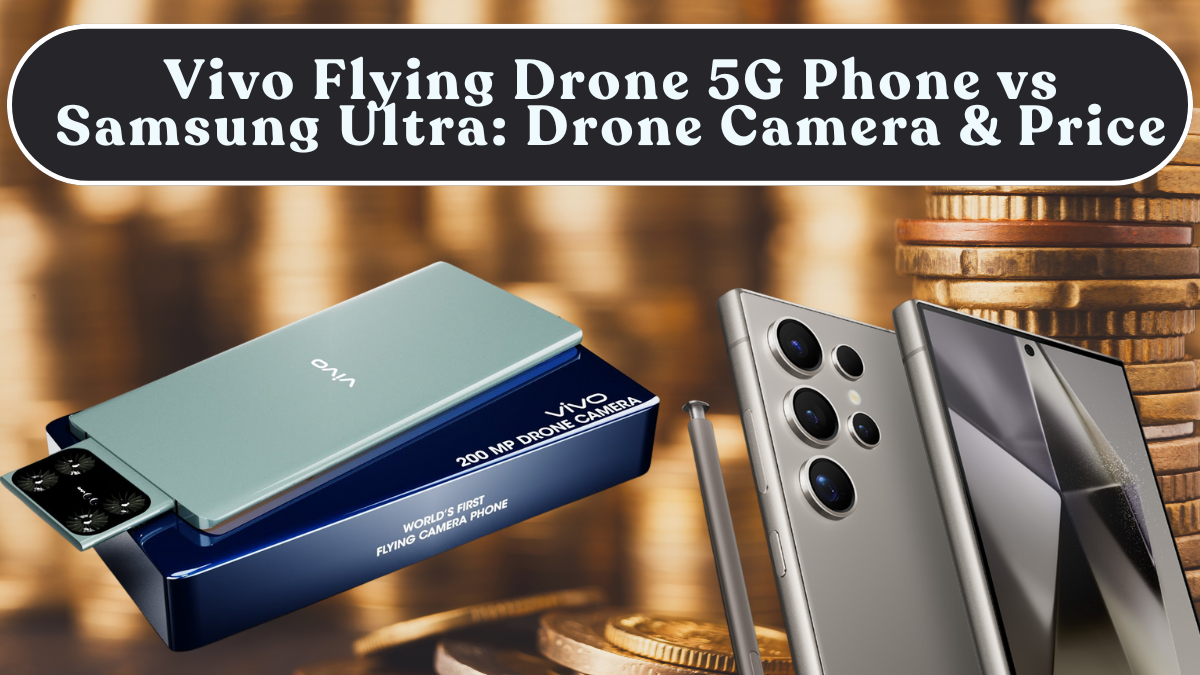The smartphone industry never stops innovating — and 2025 is proving to be a landmark year. After Samsung’s premium Ultra flagship set the bar with AI-driven photography, Vivo has stunned the market by introducing a smartphone with a built-in flying drone camera. As we approach November 2025, Indian tech enthusiasts are buzzing: how does the Vivo Flying Drone 5G Phone compare to the Samsung Ultra series that has long dominated mobile photography?
Here’s a detailed comparison focusing on camera innovation, real-world usability, performance, battery, and expected India pricing.

A New Era of Smartphone Cameras
For years, smartphone brands competed on megapixels. Now, Vivo has taken a bold leap — literally. The Vivo Flying Drone 5G Phone features a pop-out detachable mini drone camera capable of hovering independently for up to 30 seconds.
Samsung, on the other hand, continues to refine its AI quad-camera setup in the Galaxy S25 Ultra, relying on advanced computational photography rather than physical mobility.
| Feature | Vivo Flying Drone 5G Phone | Samsung Galaxy S25 Ultra |
|---|---|---|
| Camera Innovation | Pop-out flying drone module | Quad AI camera setup |
| Primary Sensor | 200 MP | 200 MP |
| Secondary | 50 MP ultra-wide | 12 MP ultra-wide |
| Drone Flight Time | 25–30 seconds | Not applicable |
| Drone Range | Up to 8 metres | Fixed lens |
| Stabilisation | AI-assisted + gyro | OIS + EIS |
Verdict: Vivo’s concept leads in innovation, allowing users to capture angles previously impossible for smartphones — while Samsung still rules in stability and image processing.
Design & Build
The Vivo Flying Drone 5G Phone resembles a futuristic slab with a hidden camera dock. The drone module slides out from the top edge, powered by micro-propellers and AI stabilisation. Despite this, the phone weighs around 215 grams, comparable to the Samsung Ultra.
Samsung retains its rectangular industrial design with premium finishes, offering IP68 water resistance, while Vivo’s model provides only IP52 splash protection due to its moving parts.
| Aspect | Vivo Flying Drone 5G Phone | Samsung Ultra |
|---|---|---|
| Weight | 215 g | 232 g |
| Protection | IP52 | IP68 |
| Materials | Aluminium frame, Gorilla Glass | Armour Aluminium + Gorilla Glass Victus 3 |
| Build Type | Drone mechanism housing | Solid block design |
Verdict: Samsung wins on durability, but Vivo’s innovation makes it the more conversation-worthy device.
Performance & Processor
Vivo equips its concept device with the Snapdragon 8 Elite Gen 5 chipset — the same one found in the Galaxy S25 Ultra. Both models deliver top-tier performance with up to 16 GB LPDDR5X RAM and UFS 4.0 storage.
| Performance Spec | Vivo Flying Drone 5G Phone | Samsung S25 Ultra |
|---|---|---|
| Processor | Snapdragon 8 Elite Gen 5 | Snapdragon 8 Elite Gen 5 |
| RAM | 12 GB / 16 GB | 12 GB / 16 GB |
| Storage | 256 GB / 512 GB | 256 GB / 1 TB |
| OS | OriginOS 6 (Android 15) | One UI 7 (Android 15) |
Gaming and multitasking remain flawless on both, but the Vivo model can get warm when drone recording is used for extended durations.
Verdict: Samsung offers steadier thermal control, while Vivo wins the tech showcase with its drone features.
Camera Experience in Real Use
Vivo Flying Drone 5G Phone
The drone camera can hover up to 8 metres from the user, capturing unique tracking shots, aerial selfies, or overhead perspectives during events. It supports gesture control, allowing users to start recording or adjust angle mid-flight.
The main 200 MP sensor provides crisp stills, while the drone module’s AI-assisted gimbal ensures smooth flight videos. However, the battery drains quickly if used for long drone sessions.
Samsung Galaxy S25 Ultra
Samsung sticks to its tried-and-tested formula — a 200 MP primary sensor, a 12 MP ultra-wide, and two telephoto lenses (3x and 10x optical). Its AI Object Eraser 3.0 and Nightography+ software deliver studio-grade photos even in low light.
Verdict: Vivo’s drone system offers unmatched creativity; Samsung remains unbeatable in clarity, stability, and low-light performance.
Battery & Charging
| Feature | Vivo Flying Drone 5G Phone | Samsung Ultra |
|---|---|---|
| Battery Capacity | 5,200 mAh | 5,000 mAh |
| Charging | 120 W fast charging | 45 W wired, 15 W wireless |
| Battery Life | 1 day (with drone use) | 1.5 days |
Vivo’s high-speed 120 W charging refuels the device in around 20 minutes, ideal for users constantly experimenting with the drone camera. However, frequent drone use consumes around 15–20% extra battery daily.
Verdict: Samsung offers better endurance; Vivo compensates with faster recharging and higher flexibility.
Software & AI Integration
Vivo’s OriginOS 6 includes a dedicated Drone Camera Hub, letting users pre-program flight patterns and follow subjects automatically. It integrates AI subject tracking — perfect for vlogs, weddings, and events.
Samsung’s One UI 7 leans on AI Smart Capture, Adaptive Tone Mapping, and ProRAW+ mode, designed for consistent photography results without mechanical movement.
Verdict: Vivo delivers the wow factor; Samsung guarantees consistency and precision.
Connectivity & Extras
Both phones offer complete flagship-level connectivity.
| Feature | Vivo Flying Drone 5G Phone | Samsung S25 Ultra |
|---|---|---|
| 5G Bands | 16 | 17 |
| Wi-Fi | 7 | 7 |
| Bluetooth | 5.4 | 5.4 |
| Audio | Stereo, Dolby Atmos | Stereo, Dolby Atmos |
| Extras | Drone dock, air gesture control | S-Pen, Dex mode |
Verdict: Samsung’s productivity features like S-Pen and Dex make it more business-friendly, while Vivo focuses purely on content creation and innovation.
India Price Expectations (November 2025)
| Model | Variant | Expected Price (₹) |
|---|---|---|
| Vivo Flying Drone 5G Phone | 12 GB + 256 GB | ₹89,999 |
| Samsung Galaxy S25 Ultra | 12 GB + 256 GB | ₹1,24,999 |
Verdict: Vivo’s pricing strategy undercuts Samsung by nearly ₹35,000, offering an early glimpse at the next big wave in smartphone design.
Which Phone Makes More Sense for Indian Buyers?
-
Choose Vivo Flying Drone 5G Phone if you’re a vlogger, filmmaker, or tech enthusiast who values innovation, aerial creativity, and futuristic features.
-
Choose Samsung Ultra if you’re a professional or camera purist who prefers reliability, water resistance, and superior photo algorithms.
Verdict: Vivo’s drone concept makes it a head-turner; Samsung remains the benchmark for day-to-day excellence.
Final Verdict
The Vivo Flying Drone 5G Phone proves that smartphone innovation in India is far from over. While Samsung perfects the art of AI photography, Vivo explores what lies beyond — mobility, autonomy, and creativity in your pocket.
In practical use, Samsung is still the better daily performer, but Vivo deserves credit for pushing boundaries and redefining how we think of smartphone cameras.
Overall Verdict: The Vivo Flying Drone 5G Phone is a daring innovation for creators; Samsung Ultra remains the reliable all-round champion.
FAQs
How long can the Vivo drone camera fly?
It can hover for up to 25–30 seconds per flight within a range of 8 metres.
Is the drone module waterproof?
No, it’s splash-resistant only. Avoid using it in rain or heavy wind.
Does the Vivo Flying Drone Phone overheat?
Mild heating occurs during extended drone use, but software manages temperature effectively.
Which phone has better low-light performance?
Samsung’s S25 Ultra still leads with its advanced Nightography+ algorithms.
What is the expected India launch price of Vivo’s drone phone?
The expected starting price is around ₹89,999 in India.
Click here to know more.
